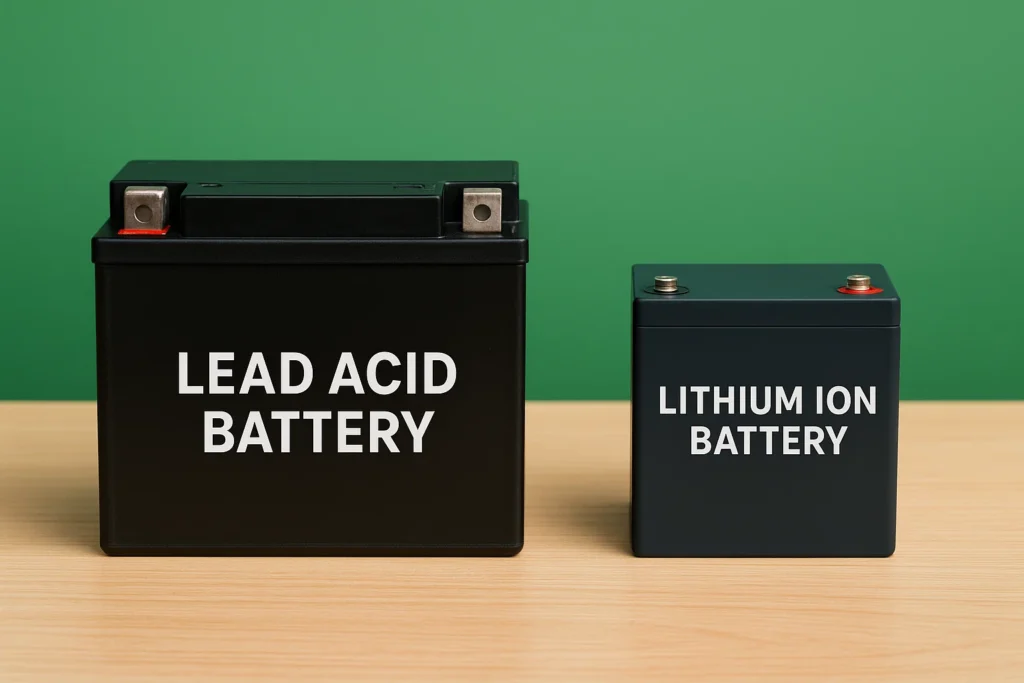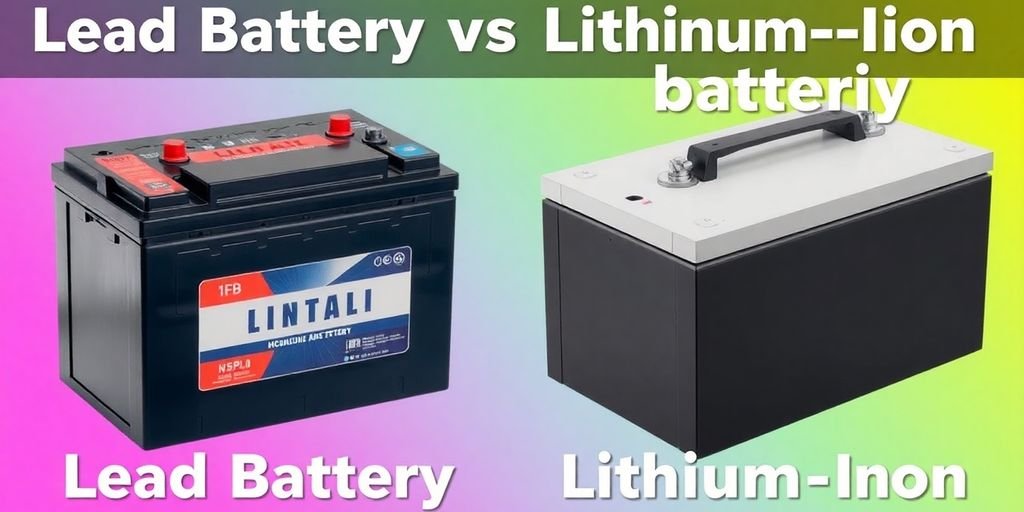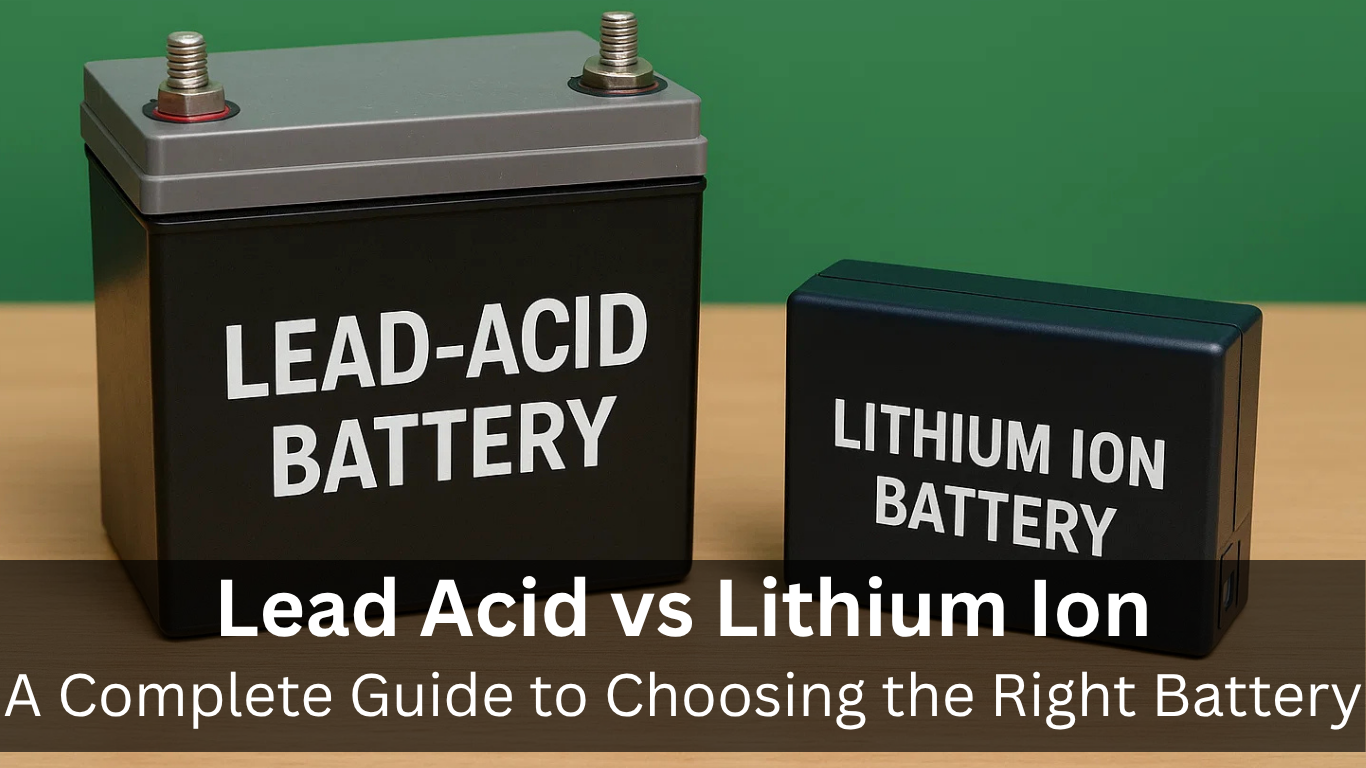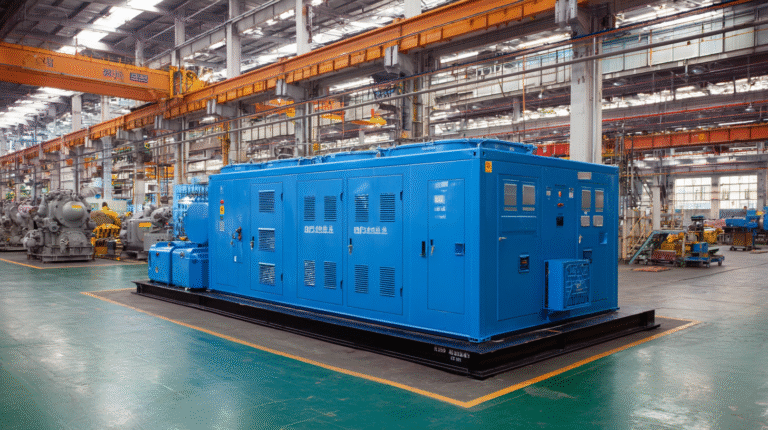Lead Acid vs Lithium Ion: A Complete Guide to Choosing the Right Battery
When it comes to picking a battery, the choice between lead acid vs lithium ion can be a bit tricky. Both types have their own strengths and weaknesses, making them suitable for different situations. Whether you need a battery for your car, a solar energy system, or a portable device, understanding how these batteries work and what they offer can help you make the right choice. In this guide, we’ll break down the key differences and help you figure out which battery is best for your needs.
Key Takeaways
- Lead acid batteries are cheaper upfront but have shorter lifespans compared to lithium-ion batteries.
- Lithium-ion batteries charge faster and have higher energy density, making them ideal for high-performance applications.
- Lead acid batteries are often used in traditional setups, while lithium-ion is preferred for modern tech like electric vehicles.
- Both battery types have environmental impacts, but lithium-ion batteries are generally more sustainable with proper recycling.
- Safety is key: lead acid batteries can leak harmful materials, while lithium-ion batteries need careful handling to avoid overheating.
Understanding Battery Technologies

Before we get into the nitty-gritty of lead acid vs lithium ion battery for solar power systems, it’s important to understand the basics of each technology. The chemical reactions and construction of these batteries directly affect their performance, lifespan, and where they’re best used.
How Lead Acid Batteries Work
Lead acid batteries are a pretty old technology, dating back to the 19th century. They’re still widely used because they’re reliable and relatively inexpensive. These batteries use lead plates immersed in a sulfuric acid electrolyte. When the battery discharges, the lead dioxide positive plate and the lead negative plate react with the sulfuric acid, creating lead sulfate and water, which generates electricity.
There are several types of lead acid batteries:
- Flooded (requires maintenance)
- Sealed Lead Acid (SLA)
- Valve-Regulated Lead Acid (VRLA)
- Absorbent Glass Mat (AGM)
Each type has different advantages when it comes to maintenance, safety, and performance. Because the way lead acid batteries work is fairly simple, they tend to be cheaper to make. However, this simplicity also means they have limitations in how much energy they can store and how long they last compared to newer battery technologies. For example, when considering a commercial battery, lead acid options often present a lower initial investment.
How Lithium-Ion Batteries Work
Lithium-ion batteries are a more recent development in battery technology. These batteries use lithium compounds as the active material, often lithium iron phosphate (LiFePO4) in newer models. During charging and discharging, lithium ions move between the positive and negative electrodes through an electrolyte. This process allows for higher energy density and longer lifespans compared to lead acid batteries. The lithium ion battery benefits are numerous, making them a popular choice for many applications.
Lithium-ion batteries come in several chemistries, including:
- Cobalt-based cells like Lithium Cobalt Oxide
- Manganese-enhanced types such as Lithium Manganese Oxide
- Nickel-rich variants like Lithium Nickel Manganese Cobalt Oxide (NMC)
Lithium-ion batteries are generally more efficient and have a longer lifespan than lead acid batteries. However, they also tend to be more expensive upfront. The choice between the two often depends on the specific application and budget.
Key Differences in Chemistry
The fundamental difference lies in the chemistry. Lead acid batteries rely on a reaction between lead and sulfuric acid, while lithium-ion batteries use the movement of lithium ions between electrodes. This difference leads to significant variations in performance characteristics. The performance difference between lithium and lead acid batteries is quite noticeable, especially in terms of energy density and cycle life. Considering a deep cycle battery types for your RV? Understanding these chemical differences is crucial for making the right choice.

Performance Comparison
So, you know how these batteries work, but what about how they actually perform? Let’s get into it.
Energy Density and Capacity
Energy density is where lithium-ion batteries really shine. They pack way more punch into a smaller package. Think of it like this: a lithium-ion battery can store about 3-4 times more energy than a lead acid battery of the same weight. That’s a huge difference, especially if you’re dealing with something like an electric vehicle or a portable device where every ounce counts. Lead acid batteries usually give you around 30-50 Wh/kg, while lithium-ion can hit 100-265 Wh/kg, depending on the specific chemistry.
Charging Times
When it comes to charging, lithium-ion batteries are generally much faster. Lead acid batteries can take a long time to fully charge, sometimes up to 8-16 hours, especially if they’ve been deeply discharged. Lithium-ion batteries, on the other hand, can often be fully charged in just a few hours. This is because they can handle higher charge currents without getting damaged. Plus, lithium-ion batteries don’t have that annoying “memory effect” that some older battery types do, so you don’t have to worry about fully discharging them before recharging.
Lifespan and Cycle Life
Lifespan and cycle life are also big differentiators. Cycle life refers to how many times you can charge and discharge a battery before it starts to degrade significantly. Lithium-ion batteries typically offer a much longer cycle life than lead acid batteries.
Here’s a quick comparison:
- Lead Acid: Typically 200-500 cycles
- Lithium-Ion: Can range from 1,000 to 5,000+ cycles
- Factors like depth of discharge and operating temperature can affect these numbers.
Basically, if you’re planning on using a battery a lot, lithium-ion is the way to go. You’ll get way more use out of it before it needs replacing. This is a big deal for things like solar energy storage or electric vehicles, where you’re constantly charging and discharging the battery.
Cost Analysis
Initial Purchase Costs
Okay, let’s talk money. Upfront, lead acid batteries definitely win. You’ll spend less to get started with them. Think of it this way: you can get a basic lead acid battery for a pretty low price. Lithium-ion batteries? Not so much. They cost more initially. For example, a small lead acid battery might only be a few dollars, while even a basic lithium-ion cell can be over ten dollars. That difference adds up fast, especially if you need a bunch of batteries. So, if you’re on a tight budget, lead acid might seem like the obvious choice at first. But hold on, there’s more to the story.
Long-Term Value
Don’t let the initial price fool you. Lithium-ion batteries often give you more bang for your buck in the long run. Think about it like this: while you pay more upfront, you might not have to replace them as often. Lead acid batteries tend to have shorter lifespans, meaning you’ll be buying replacements sooner. Lithium-ion batteries can last for years longer, potentially saving you money over time. Plus, they’re often more efficient, wasting less energy during charging. That can lower your electricity bill, adding to the savings. It’s like buying a more expensive car that gets better gas mileage – you pay more at first, but you save money on fuel later. Considering battery recycling is also important for long-term value.
Maintenance and Replacement Costs
Let’s break down the ongoing costs. Lead acid batteries often need more attention. You might have to check water levels, clean terminals, and make sure they’re properly ventilated because they release gas when charging. All that takes time and effort. Lithium-ion batteries, on the other hand, are pretty much maintenance-free. You install them, and you’re good to go. Also, because lead acid batteries don’t last as long, you’ll be replacing them more often. Here’s a quick comparison:
- Lead Acid:
- Lower initial cost
- Higher maintenance
- Shorter lifespan
- More frequent replacements
- Lithium-Ion:
- Higher initial cost
- Little to no maintenance
- Longer lifespan
- Fewer replacements
So, while lead acid batteries might seem cheaper at first, the long-term costs of maintenance and frequent replacements can add up. Lithium-ion batteries might cost more upfront, but their longer lifespan and lower maintenance can make them a better value in the end. It really depends on how you plan to use the batteries and how long you need them to last. For example, if you are using a lithium-ion setup for solar power, you will want to consider the long-term value.
Applications and Use Cases

Common Uses for Lead Acid Batteries
Lead-acid batteries have been around forever, and they’re still kicking for a reason. You’ll find them in places where you need reliable power, but maybe don’t want to spend a ton of money upfront. Think of them as the workhorses of the battery world.
- Automotive starting batteries: Pretty much every car on the road uses a lead-acid battery to get the engine going.
- Backup power systems: Things like UPS systems for computers or emergency lighting often rely on lead-acid.
- Golf carts and electric wheelchairs: These need a good amount of power, but weight and size aren’t usually huge concerns.
- Off-grid energy storage: While lithium-ion is becoming more popular, lead-acid is still used in some solar setups, especially in older or budget-conscious systems.
Lead-acid batteries are generally chosen when cost is a primary concern and the application doesn’t demand extremely high performance or a long lifespan. They’re a known quantity, and there’s a well-established infrastructure for recycling them.
Common Uses for Lithium-Ion Batteries
Lithium-ion batteries are the cool kids on the block. They’re lighter, more powerful, and last longer than lead-acid, but they also cost more. You see them everywhere these days.
- Consumer electronics: Laptops, smartphones, tablets – anything portable and electronic probably runs on lithium-ion.
- Electric vehicles: From Teslas to electric scooters, lithium-ion is the battery of choice for EVs because of its high energy density.
- Power tools: Cordless drills, saws, and other tools benefit from the lightweight and powerful nature of lithium-ion.
- Grid-scale energy storage: Big battery farms that store energy from solar and wind farms are increasingly using lithium-ion.
Choosing Based on Application
Okay, so how do you pick the right battery for the job? It really comes down to what you need the battery to do and what your priorities are. Here’s a quick rundown:
- Cost: If you’re on a tight budget, lead-acid is probably the way to go. They’re cheaper upfront.
- Weight and size: If you need something lightweight and compact, lithium-ion wins hands down. Think about portable devices or EVs where every pound counts.
- Lifespan: Lithium-ion batteries generally last longer and can handle more charge/discharge cycles than lead-acid. This can save you money in the long run, even though they cost more initially.
- Performance: If you need high power output and fast charging, lithium-ion is the better choice. They can deliver more power when you need it.
- Environment: Both types of batteries have environmental concerns, but lithium-ion is generally considered to be more sustainable in the long run, especially with advances in recycling technology. Consider community programs that promote responsible battery disposal.
Here’s a simple table to summarize:
| Feature | Lead-Acid | Lithium-Ion |
|---|---|---|
| Cost | Lower | Higher |
| Weight | Heavier | Lighter |
| Lifespan | Shorter | Longer |
| Energy Density | Lower | Higher |
| Charging Time | Slower | Faster |
| Common Uses | Cars, backup power, golf carts | EVs, laptops, power tools, grid storage |
Environmental Impact
It’s easy to forget about what happens to batteries after they’re used up, but it’s a big deal. Both lead acid and lithium-ion batteries have environmental consequences, and it’s important to understand them to make responsible choices. Let’s take a look at the impact of each.
Recyclability of Lead Acid Batteries
Lead acid batteries have a pretty good recycling rate, which is a definite plus. The infrastructure for recycling them is well-established, and a large percentage of the battery components can be recovered and reused. However, the recycling process itself isn’t perfect. It can release harmful substances if not done properly. Here’s a quick rundown:
- High recycling rates compared to other battery types.
- Established recycling infrastructure.
- Potential for lead contamination if recycling isn’t handled correctly.
Sustainability of Lithium-Ion Batteries
Lithium-ion batteries are a different story. While they don’t contain lead, they have other materials that pose challenges for recycling. The recycling process is more complex and expensive, and the recycling rates are lower than lead acid. Plus, the extraction of lithium and other materials used in these batteries can have its own environmental impacts. Consider these points:
- Lower recycling rates compared to lead acid.
- Complex and costly recycling processes.
- Environmental impacts from mining lithium and other materials.
Comparative Environmental Footprint
When you compare the overall environmental footprint, it’s not a simple win for either type. Lead acid batteries have the risk of lead contamination, but high recycling rates help offset this. Lithium-ion batteries avoid lead, but their lower recycling rates and the impacts of material extraction are concerns. LifePO4 batteries are becoming more popular because they don’t have heavy metals and are more recyclable. It really depends on how well each type is managed throughout its life cycle.
Ultimately, the environmental impact depends on responsible manufacturing, use, and disposal. Choosing batteries from companies committed to sustainable practices and proper recycling is key to minimizing the environmental footprint.
Safety Considerations
When it comes to batteries, safety is a big deal. Both lead acid and lithium-ion batteries have their own set of potential hazards, and it’s important to know what they are and how to avoid them. Let’s break down the risks and best practices for each type.
Risks Associated with Lead Acid Batteries
Lead acid batteries, while reliable, aren’t without their dangers. The main concerns revolve around the sulfuric acid electrolyte they contain.
- Acid Burns: Sulfuric acid is highly corrosive. If a battery leaks or is damaged, contact with skin or eyes can cause severe burns. Always wear protective gear like gloves and eye protection when handling these batteries.
- Hydrogen Gas: Lead acid batteries produce hydrogen gas during charging, which is flammable and can be explosive in confined spaces. Ensure proper ventilation when charging.
- Lead Exposure: Lead is a toxic heavy metal. While the lead plates are sealed inside the battery, improper disposal or damage can lead to lead contamination of the environment. Recycling lead-acid batteries is super important.
Working with lead-acid batteries requires caution. Always prioritize safety by wearing protective gear, ensuring proper ventilation, and handling them carefully to prevent leaks or damage. Proper disposal is also key to preventing environmental contamination.
Risks Associated with Lithium-Ion Batteries
Lithium-ion batteries are generally safe, but they do have some unique risks to be aware of. The biggest concern is thermal runaway, which can lead to fires or explosions.
- Overcharging/Over-Discharging: Charging a lithium-ion battery beyond its voltage limit or discharging it too deeply can cause internal damage and increase the risk of thermal runaway. Use a quality charger designed for lithium-ion batteries.
- Physical Damage: Puncturing, crushing, or otherwise damaging a lithium-ion battery can cause a short circuit and lead to a fire. Handle with care and avoid dropping or exposing to extreme pressure.
- Manufacturing Defects: In rare cases, manufacturing defects can cause lithium-ion batteries to fail. Buy from reputable brands and check for any signs of swelling or damage before use.
Best Practices for Safe Use
No matter which type of battery you’re using, following these best practices can help minimize risks:
- Read the Manual: Always read and follow the manufacturer’s instructions for charging, use, and storage.
- Use the Right Charger: Use a charger specifically designed for the type of battery you’re using. Don’t mix and match chargers.
- Inspect Regularly: Check batteries for any signs of damage, such as swelling, leaks, or corrosion. Replace damaged batteries immediately.
- Store Properly: Store batteries in a cool, dry place away from direct sunlight and extreme temperatures. For lithium-ion, avoid storing at full charge for extended periods.
- Dispose Responsibly: Recycle batteries properly at designated collection points. Don’t throw them in the trash. Improper lithium battery disposal can be dangerous.
Choosing the Right Battery
Factors to Consider
Okay, so you’ve made it this far, and hopefully, you’re starting to get a handle on the lithium vs lead acid battery comparison. There’s a lot to think about, right? Before you pull the trigger on a purchase, let’s break down the main things you need to keep in mind. It’s not just about picking the fanciest or cheapest option; it’s about finding the right fit for your needs.
- Energy Needs: How much power do you actually need? Calculate your energy consumption to determine the required battery capacity.
- Budget: How much are you willing to spend upfront, and what are you expecting to pay over the long haul? Don’t forget to factor in replacement costs.
- Lifespan: How long do you need the battery to last? Consider cycle life and how frequently you’ll be using the battery.
- Environmental Conditions: Where will the battery be used? Temperature extremes can affect battery performance and lifespan.
Evaluating Your Needs
Time to get real about what you actually need. Are you looking for a best battery for solar storage to keep the lights on during a power outage? Or are you trying to power a trolling motor for weekend fishing trips? The answers to these questions will heavily influence your choice. Think about the following:
- Application: What exactly will the battery be powering? Different applications have different power requirements.
- Usage Patterns: How often will you be using the battery, and for how long each time?
- Space Constraints: How much physical space do you have available for the battery?
It’s easy to get caught up in the technical specs, but at the end of the day, the best battery is the one that meets your specific needs and fits your budget. Don’t overthink it, but do your homework.
Making an Informed Decision
Alright, you’ve considered the factors, evaluated your needs, and now it’s decision time. Here’s how to make an informed choice:
- Compare Options: Look at different models and brands within both lead acid and lithium-ion categories. Pay attention to reviews and ratings.
- Consider Total Cost of Ownership: Don’t just focus on the initial purchase price. Factor in lifespan, maintenance, and replacement costs to get a true cost comparison of lead acid and lithium ion batteries for home backup.
- Read the Fine Print: Understand the warranty terms and conditions. What’s covered, and for how long?
Choosing the right battery can feel overwhelming, but by taking a systematic approach and carefully considering your needs, you can make a decision you’ll be happy with for years to come. Good luck!
Final Thoughts on Choosing Your Battery
In the end, picking between lead acid and lithium-ion batteries really comes down to what you need. If you’re on a tight budget or using something traditional, lead acid might be your best bet. They’re cheaper upfront and still do the job for many applications. But if you want something that lasts longer and performs better, lithium-ion is the way to go. Sure, it costs more, but you get better efficiency and less hassle in the long run. Think about your specific needs, how often you’ll use the battery, and what you can afford. That way, you’ll make the right choice for your situation.
Frequently Asked Questions
What is the main difference between lead-acid and lithium-ion batteries?
The biggest difference is how they store and release energy. Lead-acid batteries are heavier and cheaper, while lithium-ion batteries are lighter, last longer, and charge faster.
Why are lead-acid batteries still used in cars?
Lead-acid batteries are reliable and affordable, making them a good choice for starting car engines.
How long do lithium-ion batteries last compared to lead-acid batteries?
Lithium-ion batteries can last about 5 to 10 years, while lead-acid batteries usually last around 3 to 5 years.
Are lithium-ion batteries safe to use?
Yes, but they need to be handled properly. They can overheat if not managed well, while lead-acid batteries can leak corrosive acid.
Which type of battery is more cost-effective in the long run?
Lithium-ion batteries are more expensive upfront, but they last longer and require less maintenance, making them more cost-effective over time.
Can I recycle lead-acid batteries?
Yes, lead-acid batteries are recyclable. They can be processed to recover lead and sulfuric acid, which can be reused.









Get emergency hot water repair Chicago anytime. Our best water heater repair company Chicago specializes in tankless water heater repair Chicago, residential water heater repair, and water heater not heating repair by certified professionals.